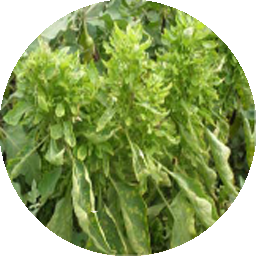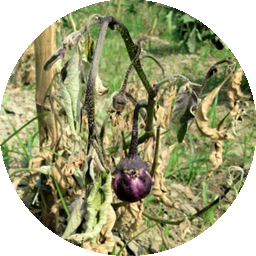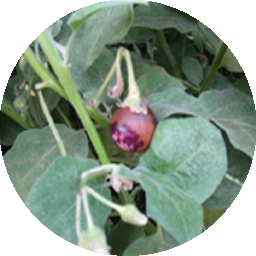Brinjal Symptoms & Management
×
Symptoms:
1. Infection is initially observed in one branch and later the entire plant shows symptoms
2. Reduction in size of newly formed leaves
3. Reduction in petiole length making the leaves appear to be sticking to the stem
4. Affected plants have narrow, soft, smooth and yellow shorter leaves
5. Internodes of the stem are also shortened
6. Axillary buds get enlarged but their petioles and leaves also remain shortened giving the plant a bushy appearance
7. Mostly there is no flowering but if flowers are formed they remain green
8. Fruiting is rare, if any fruit is formed, it becomes hard, tough and fails to mature. Young fruit turns necrotic, get mummified and cling to the plant
Management:
1.Tolerant variety: Pusa Purple Round, Pusa purple cluster and Arka sheel
2.Destruction of affected plants
3.Eradication of Solanaceous weed hosts
4.Spray Methyl demeton, 2 ml/l or Dimethoate 2 ml/l
×
Symptoms:
1. Sudden wilting and death of infected plants is the characteristic symptom. The petioles of older leaves droop down and the leaves show epinasty symptoms accompanied by yellowing and stunting of whole plant.
2. Typical browning of vascular tissues of roots and stems can be seen
3. From cross sections of infected plants whitish bacterial ooze comes out
Management:
1.Growing resistant varieties like Pant Samrat, Arka Nidhi, Arkas Kashav, Arka Neelakantha, Surya and BB 1, 44 & 49
2.Crop rotation with non Solanaceous hosts
3.Green manuring with Brassica species (Biofumigation)
4.Soil solarization with a transparent polyethylene sheet (125 μm thick) for 8-10 weeks during March-June in nurseries
5.Biological control with Pseudomonas fluorescens, P. cepaciae, Bacillus sp. & Erwinia spp
×
Symptoms:
1. The plants are attacked at all stages of growth, producing damping-off symptoms in nurseries and collar rot on young plants
2.On leaves, circular to irregular, clearly defined grayish brown spots having light centers appear. The diseased leaves become yellowish in colour and may drop off. Several black pycnidia can be seen on older spots.
3.The lesions on stem are dark brown, round to oval and have grayish centers where pycnidia develop. At the base of the stem, the fungus causes characteristic constrictions leading to canker development and toppling of plants.
4.On fruits, small pale sunken spots showing concentric rings appear which on enlargement cover entire fruit surface. These spots become watery leading to soft rot phase of the disease. A large number of dot like pycnidia also develop on such spots.
5.The infection of fruit through calyx leads to development of dry rot and fruits appear black and mummified.
Management:
1.Procuring seeds from healthy fruits followed by seed treatment with thiophanate methyl at 1g/kg seed or hot water treatment of seed at 500C for 30 minutes
2.Practicing crop rotation and summer ploughings helps in reducing initial inoculum
3.Removal and destruction of diseased crop debris
4.Spray twice with thiophanate methyl or carbendazim@0.1% at 20 days interval
5.Resistant variety: Florida Beauty. Solanum gilo, S. macrocarpa and S. integrifolium are wild resistance donors.



